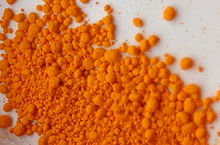
Back أكسيد الزئبق الثنائي Arabic جیوه (II) اوکسید AZB Oxid rtuťnatý Czech Quecksilber(II)-oxid German Óxido de mercurio(II) Spanish جیوه (II) اکسید Persian Elohopeaoksidi Finnish Oxyde de mercure(II) French Ocseed vercur(II) GV मर्करी(II) ऑक्साइड Hindi
 | |
 | |
| Names | |
|---|---|
| IUPAC name
Mercury(II) oxide
| |
| Other names | |
| Identifiers | |
3D model (JSmol)
|
|
| ChemSpider | |
| ECHA InfoCard | 100.040.580 |
| KEGG | |
PubChem CID
|
|
| RTECS number |
|
| UNII | |
| UN number | 1641 |
CompTox Dashboard (EPA)
|
|
| |
| |
| Properties | |
| HgO | |
| Molar mass | 216.591 g·mol−1 |
| Appearance | Yellow or red solid |
| Odor | odorless |
| Density | 11.14 g/cm3 |
| Melting point | 500 °C (932 °F; 773 K) (decomposes) |
| 0.0053 g/100 mL (25 °C) 0.0395 g/100 mL (100 °C) | |
| Solubility | insoluble in alcohol, ether, acetone, ammonia |
| Band gap | 2.2 eV[1] |
| −44.0·10−6 cm3/mol | |
Refractive index (nD)
|
2.5 (550 nm)[1] |
| Thermochemistry | |
Std molar
entropy (S⦵298) |
70 J·mol−1·K−1[2] |
Std enthalpy of
formation (ΔfH⦵298) |
−90 kJ·mol−1[2] |
| Hazards | |
| Occupational safety and health (OHS/OSH): | |
Main hazards
|
Extremely toxic, environmental pollutant |
| GHS labelling:[4] | |
  
| |
| Danger | |
| H300+H310+H330, H372, H410 | |
| P260, P262, P264, P270, P271, P273, P280, P284, P301+P316, P302+P352, P304+P340, P316, P320, P321, P330, P361+P364, P391, P403+P233, P405, P501 | |
| NFPA 704 (fire diamond) | |
| Flash point | Non-flammable |
| Lethal dose or concentration (LD, LC): | |
LD50 (median dose)
|
18 mg/kg (oral, rat)[3] |
| Safety data sheet (SDS) | ICSC 0981 |
| Related compounds | |
Other anions
|
Mercury sulfide Mercury selenide Mercury telluride |
Other cations
|
Zinc oxide Cadmium oxide |
Related compounds
|
Mercury(I) oxide |
Except where otherwise noted, data are given for materials in their standard state (at 25 °C [77 °F], 100 kPa).
| |
Mercury(II) oxide, also called mercuric oxide or simply mercury oxide, is the inorganic compound with the formula HgO. It has a red or orange color. Mercury(II) oxide is a solid at room temperature and pressure. The mineral form montroydite is very rarely found.
- ^ a b Madelung, O; Rössler, U; Schulz, M, eds. (1999). "Mercury oxide (HgO) crystal structure, physical properties". Semiconductors · II-VI and I-VII Compounds; Semimagnetic Compounds. Landolt-Börnstein - Group III Condensed Matter. Vol. 41B. Springer-Verlag. pp. 1–7. doi:10.1007/b71137. ISBN 978-3-540-64964-9.
- ^ a b Zumdahl, Steven S. (2009). Chemical Principles 6th Ed. Houghton Mifflin Company. p. A22. ISBN 978-0-618-94690-7.
- ^ "Mercuric oxide [ISO]". ChemIDPlus Advanced. United States National Library of Medicine. CAS RN: 21908-53-2. Retrieved 2022-04-14.
- ^ "Laboratory Chemical Safety Summary (LCSS): Mercuric oxide". PubChem. National Center for Biotechnology Information. CID 30856. Retrieved 2022-04-14.
- ^ "Safety Data Sheet: Mercury(II) oxide" (PDF). Thermo Fisher Scientific. 2021-12-25. Cat No. AC316790000. Retrieved 2022-04-13.
